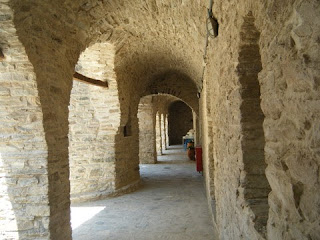Curtain Call: Ride to the Airport
Curtain Call: Baked Goods
The trip back was brutal, twenty five hours of sleep deprivation punctuated with moments of sheer panic as we sweated for an hour and a half to get past molasses paced TSA attendants in Philadelphia, to make a tight connecting flight to Jacksonville. The capper came just inches from the finish line, when a chatty customs agent leveled a saccharine smile at me and asked if I was bringing anything back anything "to eat" in my carryon bag. Kathy, who knows how I hate to buy anything in airports, was aware that I had stocked up on breakfast pastries and cheese pies from Nikos, the village baker the day before, and that this could be a fly or die moment for us if I faltered. Kathy intervened by handing the man our declaration cards and added warmly, "It's all right here, and thank you so much for everything!"
I woke up at 4:00 AM this morning, right back here in Mayport
just like I have done thousands of times before, but with the oddest sensation
that the whole trip had all just been some kind of weird hangover dream; but
I'm sitting at the keyboard drinking American coffee and munching on an ever so
slightly stale cheese pie thinking, "this really ain't too bad."
A good
entertainer knows when to get off the stage, and I had really meant to, but there is still an episode or two left to
do yet.
There was a
farewell dinner party for us up at Christos', and while we had planned to make
an early night of it, we didn't. There
may have been people from the party still sitting at the table as we were
waking up to leave, I don't know. The morning
was unusually cool, crisp, and clear. As
we headed down the mountain, the stars were still out and the sky was just
showing a faint pink glow. A string of
lights between the sea and the mountains indicated the shore line of Turkey in
the distance.
Giannis was
waiting in Kokkari to drive us to the
airport and I suspected that it had been a late night for him too. There wasn't any traffic on the road, but his
mood seemed a little too expansive for that hour of the morning. He alternatively hummed a tune that was still
playing in his head from the night before, and enlightened us on the historical
derivation of place names for settlements on Samos and "Tourkai" (Turkey)
that still lingered from Ottoman times.
I tried not to notice the 100 kph that was registering on the
speedometer, after all it was still his car, but when he braked for a cat in on
a blind curve, I was glad that in our own haste, we'd skipped our customary pot of
coffee that morning. |
| A late dinner party at Christos' |
Curtain Call: Baked Goods
The trip back was brutal, twenty five hours of sleep deprivation punctuated with moments of sheer panic as we sweated for an hour and a half to get past molasses paced TSA attendants in Philadelphia, to make a tight connecting flight to Jacksonville. The capper came just inches from the finish line, when a chatty customs agent leveled a saccharine smile at me and asked if I was bringing anything back anything "to eat" in my carryon bag. Kathy, who knows how I hate to buy anything in airports, was aware that I had stocked up on breakfast pastries and cheese pies from Nikos, the village baker the day before, and that this could be a fly or die moment for us if I faltered. Kathy intervened by handing the man our declaration cards and added warmly, "It's all right here, and thank you so much for everything!"
 |
| photos by Newell |






























































